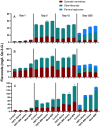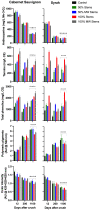Multi-Year Study of the Chemical and Sensory Effects of Microwave-Assisted Extraction of Musts and Stems in Cabernet Sauvignon, Merlot and Syrah Wines from the Central Coast of California
- PMID: 35209059
- PMCID: PMC8875832
- DOI: 10.3390/molecules27041270
Multi-Year Study of the Chemical and Sensory Effects of Microwave-Assisted Extraction of Musts and Stems in Cabernet Sauvignon, Merlot and Syrah Wines from the Central Coast of California
Abstract
Microwave technology (MW) was applied to musts and stems over three consecutive vintages in Cabernet Sauvignon, Merlot and Syrah wines from California (USA). Stems were added to musts at a rate of 50 and 100% (50% Stems and 100% Stems), either as untreated or after MW (50% MW Stems and 100% MW Stems). Stem additions lowered ethanol (up to 1.15% v/v reduction), but increased pH (up to 0.16 units) and the tannin content of the wines. In 2016, tannins increased by 103% (100% Stems), and 124% (100% MW Stems). In 2017, tannins increased by 39% in stem-added Merlot wines and by 63% (100% Stems) and 85% (100% MW Stems) in Syrah wines. In 2018, tannins in Syrah wines increased by 250% (100% MW Stems) and by 743% (100% Stems). Wines made with 50% Stems exhibited intermediate tannin contents. Must MW increased flavonols (up to 278% in Syrah wines), monoglucosylated, acylated and anthocyanin-derived pigments. Stem additions reduced wine color and polymeric pigment formation in Syrah. Must MW decreased the perception of coarseness and herbaceous flavors in Merlot, whereas stem additions increased herbaceous aromas in Syrah. Despite higher tannin contents in stem-added wines, no concomitant increases in astringency were observed.
Keywords: anthocyanins; microwave; phenolic compounds; sensory analysis; stems; tannins; wine color.
Conflict of interest statement
The authors declare no conflict of interest.
Figures









Similar articles
-
Comparative phenolic, chromatic, and sensory composition of five monovarietal wines processed with microwave technology.Heliyon. 2022 Dec 10;8(12):e12332. doi: 10.1016/j.heliyon.2022.e12332. eCollection 2022 Dec. Heliyon. 2022. PMID: 36590570 Free PMC article.
-
Microwave-assisted maceration and stems addition in Bonarda grapes: Effects on wine chemical composition over two vintages.Food Res Int. 2022 Jun;156:111169. doi: 10.1016/j.foodres.2022.111169. Epub 2022 Mar 21. Food Res Int. 2022. PMID: 35651034
-
Effect of Cap Management Frequency on the Phenolic, Chromatic, and Sensory Composition of Cabernet Sauvignon Wines from the Central Coast of California over Two Vintages.Molecules. 2024 May 26;29(11):2509. doi: 10.3390/molecules29112509. Molecules. 2024. PMID: 38893385 Free PMC article.
-
Astringency, bitterness and color changes in dry red wines before and during oak barrel aging: An updated phenolic perspective review.Crit Rev Food Sci Nutr. 2019;59(12):1840-1867. doi: 10.1080/10408398.2018.1431762. Epub 2018 Feb 16. Crit Rev Food Sci Nutr. 2019. PMID: 29381384 Review.
-
Methoxypyrazine analysis and influence of viticultural and enological procedures on their levels in grapes, musts, and wines.Crit Rev Food Sci Nutr. 2015;55(4):485-502. doi: 10.1080/10408398.2012.658587. Crit Rev Food Sci Nutr. 2015. PMID: 24915378 Review.
Cited by
-
Comparative phenolic, chromatic, and sensory composition of five monovarietal wines processed with microwave technology.Heliyon. 2022 Dec 10;8(12):e12332. doi: 10.1016/j.heliyon.2022.e12332. eCollection 2022 Dec. Heliyon. 2022. PMID: 36590570 Free PMC article.
-
Use of Microwave Maceration in Red Winemaking: Effect on Fermentation and Chemical Composition of Red Wines.Molecules. 2022 May 7;27(9):3018. doi: 10.3390/molecules27093018. Molecules. 2022. PMID: 35566365 Free PMC article.
References
-
- Casassa L.F., Larsen R.C., Beaver C.W., Mireles M.S., Keller M., Riley W.R., Smithyman R., Harbertson J.F. Sensory impact of extended maceration and Regulated Deficit Irrigation on Washington State Cabernet Sauvignon wines. Am. J. Enol. Vitic. 2013;4:505–514. doi: 10.5344/ajev.2013.13068. - DOI - PubMed
-
- Pinasseau L., Vallverdú-Queralt A., Verbaere A., Roques M., Meudec E., Le Cunff L., Péros J.-P., Ageorges A., Sommerer N., Boulet J.-C., et al. Cultivar diversity of grape skin polyphenol composition and changes in response to drought investigated by LC-MS based metabolomics. Front. Plant Scie. 2017;8:1826. doi: 10.3389/fpls.2017.01826. - DOI - PMC - PubMed
-
- Cosme F., Pinto T., Vilela A. Phenolic compounds and antioxidant activity in grape juices: A chemical and sensory view. Beverages. 2018;4:22. doi: 10.3390/beverages4010022. - DOI
-
- Somers T.C. The polymeric nature of wine pigments. Phytochemistry. 1971;9:2175–2186. doi: 10.1016/S0031-9422(00)97215-7. - DOI
-
- Da Porto C., Natolino A., Decorti D. The combined extraction of polyphenols from grape marc: Ultrasound assisted extraction followed by supercritical CO2 extraction of ultrasound-raffinate. LWT-Food Sci. Technol. 2015;1:98–104. doi: 10.1016/j.lwt.2014.11.027. - DOI
MeSH terms
Substances
Grants and funding
LinkOut - more resources
Full Text Sources

